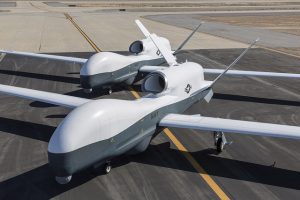Quantity has a quality all its own.
While sounding like another errant Yogi Berra quote, this simple phrase has real meaning in modern warfare. While technology is a massive force multiplier, it is not always decisive on the battlefield. An explorer armed with a six shooter gun fighting against men with spears is still in deep trouble when there are more than six angry tribesmen. If he can add more six shooters or belt fed weapons, however, the explorer will maintain a distinct advantage. The problem arises when the number of angry tribesman exceeds the number of weapons and cartridges the explorer can afford.
Shifting to a more modern setting, the extremely capable F-22 Raptor will face the same problem should it find itself up against 10 older jets. The F-22 will simply run out of ammunition. While it still has the legs to get away, the F-22 can be tactically defeated by large numbers of cheap aircraft. Unfortunately, it was too costly to buy in sufficient numbers to overcome this deficiency.
The trend in U.S. defense spending toward ever more expensive systems began in earnest during the 1970s. Faced with overwhelming Soviet superiority in numbers, the Department of Defense decided to compensate by focusing on buying high-tech platforms. This decision led to a number of successful platforms, including the F-15, F-16 and F-18 fighter aircraft, Abrams tanks, and Bradley fighting vehicles. Since then, the United States has continued to pursue cutting-edge technology that has resulted in the extremely capable F-22 and, when the testing and software development is complete, perhaps a highly capable F-35.
Unfortunately, rising costs have outstripped gains in capabilities. This in turn has severely constrained the numbers of platforms purchased. Initially, the U.S. planned to buy 750 F-22 aircraft. It ended up buying 187 operational aircraft. The B-2 suffered a similar fate. Of the planned 132 aircraft, only 21 were actually purchased.
Faced with this decline in numbers of platforms, Admiral Jonathan Greenert, chief of naval operations, recently provided a different way to assess future systems. He argued the focus should be on payloads not platforms. In doing so, he took the first step in derailing the trend of pursuing ever more exquisite capabilities in ever fewer platforms. This is particularly timely. Today, dramatic improvements in the fields of robotics, artificial intelligence, additive manufacturing, biology, and nano-materials are changing the cost/effectiveness calculation in favor of the “small, smart and cheap” against the “few and exquisite but extremely expensive.” The convergence of these technologies, and the steady decrease in costs even as capabilities increase, is rapidly expanding the destructive power, range, and precision of weapons that soon will be both widely available and relatively cheap.
Doubters about the future of small, smart platforms point to the limited payload of such systems. They note that even the Tomahawk Land Attack Missile, essentially an autonomous system after launch, can only carry a 1,000 pound warhead. Currently available commercial systems carry much smaller payloads and most for much shorter distances. In fact, today’s drones are at about the same stage of development as aircraft were in the early 1920s: relatively fragile, limited range, small payloads, and low reliability. But like aircraft of that era, much of the investment and development is being done by commercial firms for business purposes and hobbyists for fun and bragging rights. This means that progress is very rapid. Despite their fragility in 1920, by 1940, aircraft, the small, smart and cheap naval systems of the era, came to dominate the naval battle space. They did so despite massive state investment in the weapon the government saw as dominant: the battleship. Given that the rate of technological advancement has accelerated in the last century, we should expect small, smart, inexpensive drones to come to dominate the air and sea battle space within a decade or two. The ground environment is much more complex, and thus will take longer for drone type weapons to master.
Much like the 1920s to 1940s, the key for defense planners is to field the right mix of exquisite, high-tech systems and small, cheap and smart systems so that they can compensate for each other’s weaknesses.
To illustrate how the small, many and smart are beginning to transform warfare, we should start by examining why it is now possible to create small, smart and cheap platforms that have sufficient range and combat capability to fulfill the very challenging role of power projection. Then, we can turn to examining the implications of these developments for U.S. defense….































